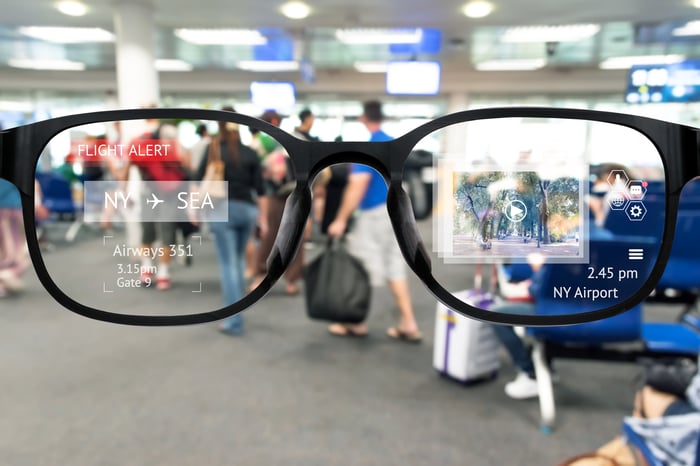The advertising industry went into a tailspin in 2022. High inflation and rising interest rates left consumers with less money to spend, so businesses are spending less to market to them. That dealt a blow to social media giant Snap (SNAP -0.18%), which generates revenue by selling digital ads on its Snapchat platform. The stock is currently trading down 87% from highs set in the fall of 2021.
While the ad industry hasn't seen a full recovery yet, Snap stock did jump 32% so far in 2023 thanks to a host of other reasons. It just announced the introduction of a new in-app chatbot that's powered by the same artificial intelligence (AI) engine responsible for OpenAI's ChatGPT. Plus, ByteDance's TikTok has attracted the attention of the U.S. government in the worst way, so one of Snapchat's fiercest competitors could soon be banned in the U.S.
Here's why those factors (and others) point to this being a major buying opportunity for Snap stock.
Snap is redesigning the advertising experience
Snap can't force its advertising customers to return to the platform in this economic environment, nor can it compel them to spend more money. What it can do is improve the experience so that those ads generate better results, which will encourage more spending.
How is Snap doing that? Through advanced technology like augmented reality (AR). Snap is a leader in the field, and it allows users to have unique experiences with the brands they love. Clothing retailers, for example, can create Lenses that allow customers to try on products virtually through the camera on their smartphone.
Recently, European fashion retailer Zalando ran an AR campaign on Snapchat and found conversions were 46% cheaper than its non-AR campaigns. In other words, it was raking in almost twice as many sales per dollar spent on Snap advertising.
Snap's revenue rose 12% in 2022 to come in at $4.6 billion. That's much slower than the 64% growth it generated in 2021, a deceleration that's mostly attributable to the slowing economy. But Snap's investments in AR could drive a major growth cycle when the advertising market rebounds, especially if those campaigns continue to produce superior results.
TikTok is in the government's crosshairs
TikTok's revolutionary short-form video platform has disrupted the social media landscape. Users find themselves consuming more content curated by AI algorithms rather than their friends and personal networks, and that shift is undoubtedly funneling ad dollars in TikTok's direction. It has become the fastest-growing mobile app in history, with over 1 billion users checking in at least once a month.
But there's a problem: TikTok's parent company, ByteDance, is based in China, and U.S. officials and others have some serious concerns about the way ByteDance is handling users' personal data. In fact, the app is already banned on government devices in the U.S. in addition to Australia, Europe, and Canada.
There are a couple of reasons for concern. First, TikTok's content recommendation engine is powerful, and Western governments are concerned it could be used to push misinformation on their citizens. Second, the Chinese government has the power to demand personal user data from China-based companies, which theoretically means a TikTok user in the U.S. could have their location pinpointed by foreign entities at any time.
Now, Congress is considering a bill that would hand President Joe Biden the power to ban TikTok -- and other apps that are deemed to be security risks -- from all devices nationwide. If that happens, billions of dollars in advertising will have to find a new home, which would be great news for Snap.
It's unclear whether a wide-scale ban would be possible from a practical standpoint, or whether it would hold up against legal challenges. President Donald Trump's attempt to ban TikTok downloads back in 2020 was blocked by a federal judge. Still, all of this political pressure might be making TikTok's advertising customers nervous.

Image source: Getty Images.
Snap's My AI chatbot has entered the conversation
There are quite a few ways for investors to gain exposure to OpenAI's revolutionary online chatbot, ChatGPT, but Snap might be the most interesting so far. Tech giant Microsoft is integrating it into its Bing search engine to change the way people seek information online. Snap, on the other hand, has introduced a version called My AI that can serve as a digital personal assistant.
It can help craft messages to friends, pick out birthday gifts, or even help you decide what you should have for dinner. Users can personalize their bot by giving it a name and changing the wallpaper on the chat screen. Snap thinks this is the beginning of a future where people use it to not only interact with their friends, but also with AI, and that could drive engagement to new heights as the technology grows smarter.
As is the case with most AI models, every conversation Snap users have with their chatbot will be used to train and improve the software, so more users equals more data, and a better product in the long run. Right now, My AI is only available to Snap's subscribers who pay $3.99 per month. There are only 2 million of them compared to its 375 million daily active users, so we'll have to wait and see how Snap strategizes a broader rollout.
According to an incredibly bullish estimate by Cathie Wood's Ark Investment Management, AI could support the addition of $200 trillion in output to the global economy by 2030. If that does happen, Snap's early foray into the space might prove to be incredibly valuable to investors in the long run.
All of those tailwinds for Snap are available in a stock that's currently valued at a price-to-sales ratio of just 4, which is near the cheapest valuation it has ever traded at. For investors, that suggests this might be a buying opportunity, especially given that the stock price could gain ground in the next few years on the back of an improving economy alone.





